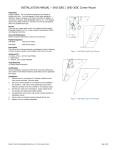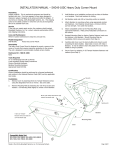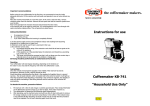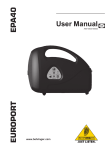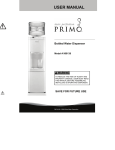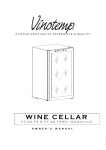Download Manual-NxWLM-2TB-Cov..
Transcript
www.broadsightsystems.com 1124 Louise Road Winston-Salem, NC 27107 Service: 1-336-837-1272 INSTALLATION MANUAL – NxWLM-2TB WARNING: Before beginning installation of this product, carefully review the safeguards and precautions found on page 2 of this manual. Unpacking Unpack carefully. This is electromechanical equipment and should be handled with care. If an item appears to have been damaged in shipment, replace it properly in its carton and notify the shipper. If any items are missing, notify Broadsight Systems, Inc. The shipping carton is the safest container in which the unit may be transported. Save it for possible future use. Service If the unit ever needs repair service, the customer should contact Broadsight Systems, Inc. for a return materials authorization (RMA) and shipping instructions. Certification Installation should be performed by a licensed professional and conform to the National Electrical Code (NEC) and any applicable local codes. Installation 1. Locate the set of keys in the hardware kit and use them to open the panel. 2. Refer to Figure 1 to locate the two set screws that attach the monitor bracket to the panel. Loosen these screws while supporting the monitor and carefully lay the monitor flat on the panel cover when removed. 3. See Figure 2 for view of interior of panel. Care and Maintenance Perform routine maintenance to keep the unit dust free. Model Designation N4WLM-2TB Covert wall mount box with 4Ch NVR with 2TB storage and 22” monitor N8WLM-2TB Covert wall mount box with 8Ch NVR with 2TB storage and 22” monitor Description The NxWLM-2TB Series are complete NVR systems installed into an enclosure that looks like an electrical panel. The system includes a Ganz NVR, a 2TB hard drive and cooling fan, all powered by a single 120VAC power plug and housed in a lockable steel box. Hardware Kit Set of 2 keys, power cord, monitor remote Tools Required 4 x Wall anchors less than 0.380” in diameter (customer supplied) with 200-lb pull-out strength Appropriate screwdriver or socket for wall anchors Flathead screwdriver Figure 1 Step 2: Loosen captive screws to access panel interior and mounting holes. 4. Use the dimensional drawing (Figure 3) to mark the panel’s mounting hole pattern, or hold the panel up to the installation surface and use the holes as a template to mark the surface. <<Instructions continue on page 3.>> Page 1 of 3 IMPORTANT SAFEGUARDS 1. 2. 3. 4. 5. 6. 7. Read Instructions - All the safety and operating instructions should be read before the unit is operated. Retain Instructions - The safety and operating instructions should be retained for future reference. Heed Warnings - All warnings on the unit and in the operating instructions should be adhered to. Follow Instructions - All operating and use instructions should be followed. Cleaning - Unplug the unit from the outlet before cleaning. Do not use liquid cleaners or aerosol cleaners. Use a damp cloth for cleaning. Attachments - Do not use attachments not recommended by the product manufacturer as they may cause hazards. Accessories - Do not place this unit on an unstable stand, tripod, bracket, or mount. The unit may fall, causing serious injury to a person and serious damage to the unit. Use only with a stand, tripod, bracket, or mount recommended by the manufacturer or sold with the product. Any mounting of the unit should follow the manufacturer's instructions and should use a mounting accessory recommended by the manufacturer. An appliance and cart combination should be moved with care. Quick stops, excessive force, and uneven surfaces may cause the appliance and cart combination to overturn. 8. Ventilation - Openings in the enclosure, if any, are provided for ventilation, to ensure reliable operation of the unit, and to protect it from overheating. These openings must not be blocked or covered. This unit should not be placed in a built-in installation unless proper ventilation is provided or the manufacturer's instructions have been adhered to. 9. Power Sources - This unit should be operated only from the type of power source indicated on the marking label. If you are not sure of the type of power supply you plan to use, consult your appliance dealer or local power company. For units intended to operate from battery power or other sources, refer to the operating instructions. 10. Grounding or Polarization - This unit may be equipped with a polarized alternating-current line plug (a plug having one blade wider than the other). This plug will fit into the power outlet only one way. This is a safety feature. If you are unable to insert the plug fully into the outlet, try reversing the plug. If the plug should still fail to fit, contact your electrician to replace your obsolete outlet. Do not defeat the safety purpose of the polarized plug. Alternatively, this unit may be equipped with a 3-wire grounding-type plug, a plug having a third (grounding) pin. This plug will only fit into a groundingtype power outlet. This is a safety feature. If you are unable to insert the plug into the outlet, contact your electrician to replace your obsolete outlet. Do not defeat the safety purpose of the grounding-type plug. 11. Power Cord Protection - Power supply cords should be routed so that they are not likely to be walked on or pinched by items placed upon or against them, paying particular attention to cords and plugs, convenience receptacles, and the point where they exit from the appliance. 12. Power Lines - An outdoor system should not be located in the vicinity of overhead power lines or other electric light or power circuits or where it can fall into such power lines or circuits. When installing an outdoor system, extreme care should be taken to keep from touching such power lines or circuits as contact with them might be fatal. U.S.A. models only - refer to the National Electrical Code Article 820 regarding installation of CATV systems. 13. Overloading - Do not overload outlets and extension cords as this can result in a fire or electric shock. 14. Object and Liquid Entry - Never push objects of any kind into this unit through openings, as they may touch dangerous voltage points or short out parts that could result in a fire or electric shock. Never spill liquid of any kind on the unit. 15. Servicing - Do not attempt to service this unit yourself as opening or removing covers may expose you to dangerous voltage or other hazards. Refer all servicing to qualified service personnel. 16. Damage Requiring Service - Unplug the unit from the outlet and refer servicing to qualified service personnel under the following conditions: a. When the power supply cord or plug is damaged. b. If liquid has been spilled or objects have fallen into the unit. c. If the unit has been exposed to rain or water. d. If the unit does not operate normally by following the operating instructions. Adjust only those controls that are covered by the operating instructions, as an improper adjustment of other controls may result in damage and will often require extensive work by a qualified technician to restore the unit to its normal operation. e. If the unit has been dropped or the cabinet has been damaged. f. When the unit exhibits a distinct change in performance--this indicates a need for service. 17. Replacement Parts - When replacement parts are required, be sure the service technician has used replacement parts specified by the manufacturer or have the same characteristics as the original part. Unauthorized substitutions may result in fire, electric shock, or other hazards. 18. Safety Check - Upon completion of any service or repairs to this unit, ask the service technician to perform safety checks to determine that the unit is in proper operating condition. 19. Coax Grounding - If an outside cable system is connected to the unit, be sure the cable system is grounded. U.S.A. models only--Section 810 of the National Electrical Code, ANSI/NFPA No.70-1981, provides information with respect to proper grounding of the mount and supporting structure, grounding of the coax to a discharge unit, size of grounding conductors, location of discharge unit,connection to grounding electrodes, and requirements for the grounding electrode. 20. Lightning - For added protection of this unit during a lightning storm, or when it is left unattended and unused for long periods of time, unplug it from the wall outlet and disconnect the cable system. This will prevent damage to the unit due to lightning and power line surges. FCC NOTICE This equipment generates and uses radio frequency energy and if not installed and used properly, that is, in strict accordance with the manufacturer's instructions, may cause interference to radio and television reception. It has been type tested and found to comply with the limits for a Class B computing device in accordance with Part 15 of FCC Rules, which are designed to provide reasonable protection against such interference in a residential installation. However, there is no guarantee that interference will not occur in a particular installation. If this equipment does cause interference to radio or television reception, which can be determined by turning the equipment off and on, the user is encouraged to try to correct the interference by one or more of the following measures: Relocate the monitor away from the TV/radio receiver. Plug the monitor into a different wall outlet so that the console is on a different branch circuit. Re-orient the TV/radio antenna. If necessary, the user should consult the dealer or an experienced radio/television technician for additional suggestions. NOTE: Changes or modifications to the unit may void FCC compliance. Page 2 of 3 5. Drill out the mounting surface and install fasteners with a minimum 200-lb pull-out strength. Leave a gap between the screw head and the wall for hanging the panel. 6. Before hanging the panel, punch out the desired knockout that will accept the power cord. Install the cord through this hole. 7. Hang the panel on the mounting screws, open the panel, lower the screen, and tighten the screws/anchors until secure. 8. Run conduit to the unit if required and feed the power cord through the conduit. 9. Connect power to the system and ensure the NVR powers up before reattaching the monitor to the panel (see Figure 1). 10. Refer to the Quick Start Guide attached to the cover and the NVR User Manual to configure the system. 11. To conserve power, always turn the monitor off before closing the panel. 12. Close the cover and use the keys to lock the cover in place. Figure 2 Internal view of opened panel. Mounting holes Insert female end of IEC power cord here. Figure 3 Dimensional drawing for mounting hole locations. Units shown are inches. ©2013 Broadsight Systems, Inc. 06/13 Page 3 of 3



